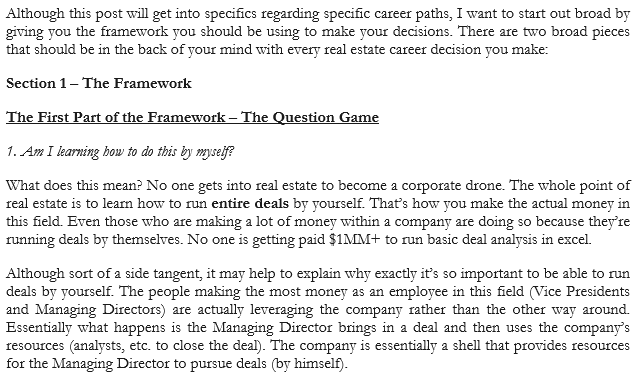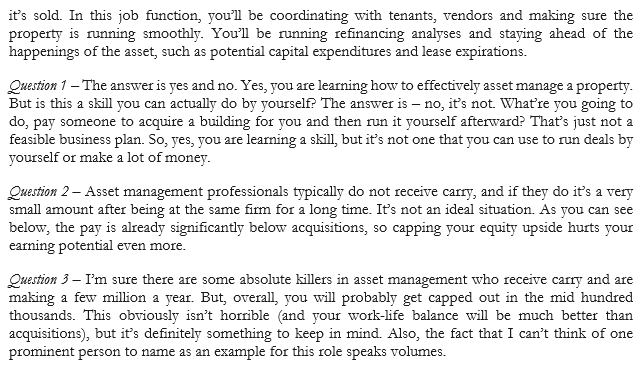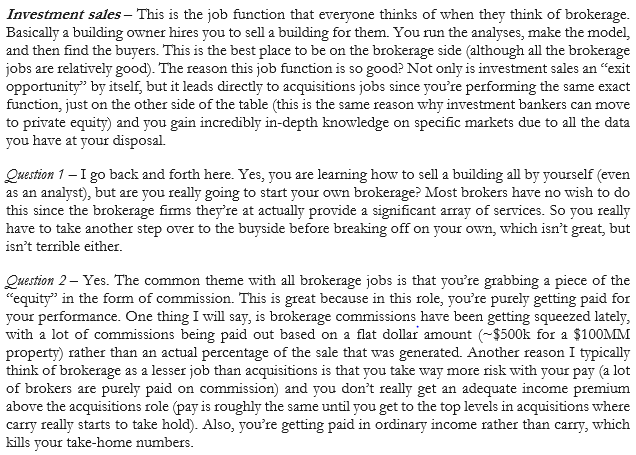
Think people go about choosing a market all wrong. RE investors make money on mispricings
Smaller mkt=less competition=less price discovery=more mispricings=easier to generate outsized returns
So your main criteria for a mkt should be "place with the least competition"
THREAD:
Smaller mkt=less competition=less price discovery=more mispricings=easier to generate outsized returns
So your main criteria for a mkt should be "place with the least competition"
THREAD:
https://twitter.com/kade_johnston/status/1437895740328714242
Most people will tell you to look for population growth, etc
But that just means more competition
If 15 firms are bidding on a deal (like in bigger/higher growth markets) there's no mispricing and only way you get outsized returns is if you're lucky or have a unique biz plan
But that just means more competition
If 15 firms are bidding on a deal (like in bigger/higher growth markets) there's no mispricing and only way you get outsized returns is if you're lucky or have a unique biz plan
So (as long as you're searching for short term flips) I would ignore all of those "population growth"-type stats entirely
The only stat that matters is finding a market that has the most mispricings. Everything else is essentially useless noise
The only stat that matters is finding a market that has the most mispricings. Everything else is essentially useless noise
Why is that? Well main difference in practice between investing in *expected* high growth cities vs lower growth is underwriting rent growth
Typically the tradeoff is this: In higher growth cities/areas you have more competition in exchange for higher future expected rent growth
Typically the tradeoff is this: In higher growth cities/areas you have more competition in exchange for higher future expected rent growth
So process of finding a deal is the same, process of raising equity is the same, process of underwriting is (mostly) the same, process of asset management is the same
All that changes is you have more competition (in exchange for some future rent growth that may not happen)
All that changes is you have more competition (in exchange for some future rent growth that may not happen)
That means that if you go to smaller markets, exploit the lower competition and find mispricings, you're actually taking *less* risk - because you're not actually betting on anything in the future, you're only modeling the in-place cashflows (and maybe sub-inflation rent growth)
Ex: if you buy at a 3 cap in Arizona and rents don't grow, your deal is actually in very rough shape
Whereas it's actually hard to go really wrong in a lot of higher cap rate, lower growth areas - and you can make a ton of money in them without assuming any rent growth
Whereas it's actually hard to go really wrong in a lot of higher cap rate, lower growth areas - and you can make a ton of money in them without assuming any rent growth
For example, let's say you're looking at a deal in a Tier 2/3+ area for a 5.5% cap rate. Purchase price is ~$2.6MM, making the NOI ~$144k
Rents are currently $1,000. Your business plan is to renovate the units to increase rents to market ($1,200)
Rents are currently $1,000. Your business plan is to renovate the units to increase rents to market ($1,200)
You price out renovations and realize it’ll cost ~$7,500 unit. That means the return on cost of the renovation will be 32% ($200 rent increase*12 months/$7,500 cost)
You realize immediately that this’ll be accretive as your base yield in the deal is 5.5% (the initial cap rate)
You realize immediately that this’ll be accretive as your base yield in the deal is 5.5% (the initial cap rate)
The 32% yield on the new renovations will definitely “drag up” your initial 5.5% yield, which is exactly what you want
What will be the overall effect on your stabilized yield as a result of the 32% return on cost?
What will be the overall effect on your stabilized yield as a result of the 32% return on cost?
Well the total cost of renovations is $150k ($7,500*20 units). Added on to the purchase price of $2.6MM, that gives you a total cost of ~$2.75MM
Now we need the other side of the equation - the new NOI
Now we need the other side of the equation - the new NOI
For your new income amount, the total rent increase is $200*20 units*12 months = $48k. Added together with the in-place income of $240k ($1,000*20 units*12 months), that gives you a stabilized income of $288k
The expenses actually stay the same as nothing is changing aside from the amount of rent being paid. So the expenses of $96k remain, making the new NOI $192k ($288k-$96k)
So, your new stabilized yield is ~7% ($192k/$2.75MM).
So, your new stabilized yield is ~7% ($192k/$2.75MM).
You’ve added 150 bps to your stabilized yield, which is incredible
But what can you do with your newfound yield?
But what can you do with your newfound yield?
You essentially have 3 options
1. Cashflow (the higher yield means that there’s a bigger spread from your debt, which means your cash-on-cash will increase)
2. Refinance (your building value has increased due to higher income)
3. Sell (your building value has increased)
1. Cashflow (the higher yield means that there’s a bigger spread from your debt, which means your cash-on-cash will increase)
2. Refinance (your building value has increased due to higher income)
3. Sell (your building value has increased)
Since this is a short term hold, we'll assume you sell
The building is now worth ~$3.5MM ($192k/5.5% market cap rate). Since you bought for $2.6MM, that’s a hefty profit over a short hold period (we'll assume you held for 3 years)
The building is now worth ~$3.5MM ($192k/5.5% market cap rate). Since you bought for $2.6MM, that’s a hefty profit over a short hold period (we'll assume you held for 3 years)
~$900k profit + ~$650k initial investment (at 75% LTV debt) = $1.55MM total proceeds. ~$1.55MM total proceeds/~$650k initial investment = ~2.3x equity multiple over ~3 years
Not bad at all, especially considering you did it without assuming any market rent growth
Not bad at all, especially considering you did it without assuming any market rent growth
So really, the name of the game is finding deals where there’s a large enough spread between the market cap rate and your stabilized yield
This is why starting out in a Tier 1 market doesn’t make much sense at all. It’s nearly impossible to find deals with a ~150 bps+ spread
This is why starting out in a Tier 1 market doesn’t make much sense at all. It’s nearly impossible to find deals with a ~150 bps+ spread
In this scenario, who cares if there's no rent growth during the short hold period (you're forcing rent growth through renovation anyway). You're able to neutralize the main drawback of lower growth cities and capitalize on the benefits (less competition)
You're working smart
You're working smart
So to recap, Tier 3+ cities/areas have
1. Less competition - (not only is there less overall competition but the quality of competition is lower - you're not competing against sophisticated investors)
2. Ability to rely on less aggressive assumptions ("safer" assumptions)
1. Less competition - (not only is there less overall competition but the quality of competition is lower - you're not competing against sophisticated investors)
2. Ability to rely on less aggressive assumptions ("safer" assumptions)
3. More controllable strategy - if you're relying on forced value-add (which you control), that makes a lot more sense than relying on market growth (which you don't control)
4. Higher initial cap rates - higher initial cap rate means a larger spread between interest rate
4. Higher initial cap rates - higher initial cap rate means a larger spread between interest rate
and cap rate. It also means there's more margin for error on the exit (exiting an expected 4% cap for a 5% cap is worse mathematically than exiting an expected 7% cap rate for an 8% cap rate)
5. Can develop better relationships with brokers to find better deals (less competition)
5. Can develop better relationships with brokers to find better deals (less competition)
All of this means that it's simply easier to find mispricings. And as you saw above, mispricings (which allow you to find ~150+ bps spread) are all you need to make a lot of money in real estate (once again, assuming you're only holding for shorter term flips)
This isn’t to say that you shouldn’t invest in Tier 1 cities, there’s a lot of money to be made in them (and they're plenty of arguments for them as well)
Just that if you’re starting your real estate entrepreneurial journey, a Tier 2/3+ city makes a lot more sense
Just that if you’re starting your real estate entrepreneurial journey, a Tier 2/3+ city makes a lot more sense
• • •
Missing some Tweet in this thread? You can try to
force a refresh

















